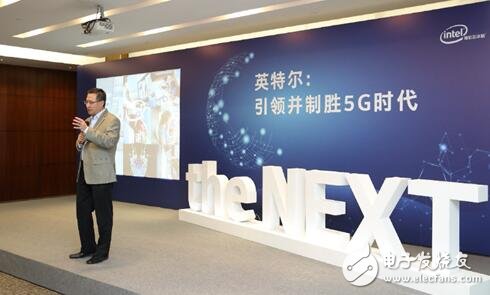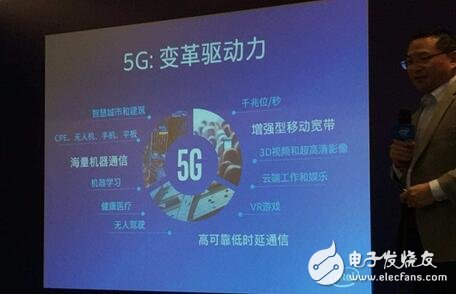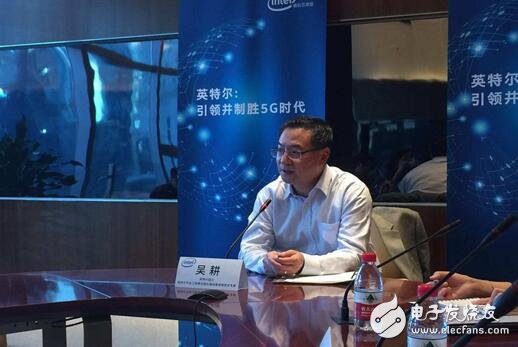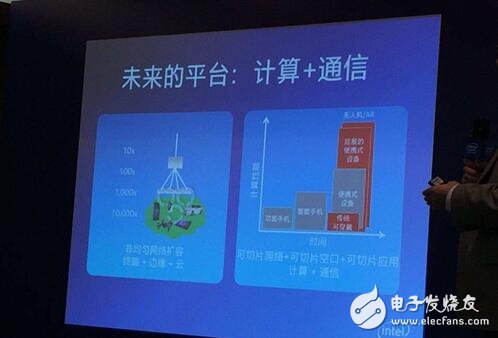Today, 4G has not yet become fully popular, 5G has become a hot topic, sweeping away. All this is due to the rise of the Internet of Things. The Internet of Everything is an era in which people try to connect all the "things" with numbers and give them "computation" capabilities, communication and computing, creating opportunities for giants like computing in Intel.

In the past, everyone's impression of 5G mostly stayed at the most intuitive feeling of higher bandwidth and lower latency. At an Intel 5G technology media exchange meeting, Intel Platform Engineering Division wireless standard chief speed expert Wu Dr. Geng explained the difference between 5G and 4G in a way that is not common to us, and proposed that the problem of communication computing in the 5G era will become a reality.

What is the difference between 5G and the other one to four generations?
If it is about a decade from a capacity perspective. Over the past few generations, each generation has provided approximately one thousand times capacity expansion. Wu Geng said, “How did the capacity increase of one thousand times of capacity in the past ten years? It is composed of three parts. First of all, it is the upgrade of air interface technology. In the past ten years, we have improved. 20 times the average efficiency. Second, when there are more users, we need to give more spectrum, the global countries, China, the United States, Europe, have done a lot of work on the frequency, the spectrum increase over the past decade 25 Times. These two numbers are multiplied, and then some improvements are made in the network architecture and terminal form. We reach a thousand."
From a device perspective, today's main devices are smartphones, PCs, tablets, and computers. Intel predicts that the number of devices connected to each other through the network will reach 50 billion in 2020, from embedded devices in sports equipment, robots and driverless cars, to smart homes, smart cities, connected factories, smart hospitals, etc. Need to access the network. This means that the data will be like a tsunami. Intel predicts that in the near future, the connected factory will generate 1 million GB of data per day, the smart hospital will produce 4000 GB/day, and the driverless will generate 1 GB/sec of data. the amount. In response to these massive amounts of data, 4G networks are far from meeting demand, which puts higher demands on 5G for next-generation wireless communication networks - more flexible, efficient, stable and low-cost to carry hundreds of millions of A wide range of things and devices for wireless connectivity and interoperability.
4G is mainly used for communication between a single terminal and a certain base station, while 5G refers to communication between all devices including a fixed device and a mobile device within its network coverage, which is a seamless binding of all devices. Communication networks connected together. This means that in addition to the transmission rate, connection rate, and low latency, 5G also involves computing power.
Wu Geng believes that 5G is the key technology variable that drives the intelligent interconnection of all things. The core is that 5G has surpassed communication itself and has become an ecosystem of integration of connection, computing and cloud. In the past, we have seen the form of cloud + terminal. The future network form may be the structure of terminal + edge + cloud formation. The function of the network is continuously moving downwards. The terminal in the future is no longer the last point of communication, but The starting point of a communication node, each of which becomes a mobile base station, and this ecological infrastructure can cope with data tsunami impact, tens of billions of connections, ubiquitous computing, and ubiquitous intelligence in the era of intelligent Internet connectivity. .
The diversity of equipment and the complexity of the network make the 5G and the previous 2G/3G/4G fundamentally different. This is also destined to be the terminator of equipment manufacturers, chip vendors, operators... The giants of all relevant industries will participate and work together.
Spectrum resources are one of the biggest challenges facing 5G
5G is dealing with the impact of data tsunami, higher bandwidth, faster connection, while enjoying the convenience of high transmission rate, there is a big challenge that we always need to face, that is, spectrum Resources.

"In order to achieve a higher level of communication technology for the next generation, the current capacity of the air interface has reached a very high level, and the entire industry can be three to five times in the spectrum in the next ten years, which is quite good." As mentioned, “spectrum is different from other things. It is a natural resource and limited. Now the base of the spectrum is 1 GHz, and 5 to 10 times of the spectrum must be given globally from 5 to 10 GHz. Wireless networks, commercial networks, including WiFi, cellular mobile communication networks, we are basically under 6GHz. Now need 5 to 10 GHz, where are these spectrums? Every country is very challenging in terms of spectrum. One of the topics, spectrum is a natural resource, and it is a finite amount of non-renewable. It is used and is a huge challenge for every country."
The challenge we face is how to achieve a breakthrough in limited spectrum resources, although it can be 3 to 5 times. This requires one more dimension, which is the spectrum utilization of space. The traditional frequency utilization rate is that each Hertz can transmit a few bits. Now we need to add one dimension to this, such as how many bits per square meter, per square centimeter, and per Hz per second, so we need to add this space. This has led us to pay attention to the large-scale antenna technology, the so-called MIMO (MulTIple-Input MulTIple-Output), more and more. It actually needs to find more space, then the network density needs to be improved, and the complexity of the entire network is even higher.
The balance between performance and power consumption is a problem that the entire industry needs to solve.
Multi-mode/multi-connection technology is critical to 5G success. In the future, multi-mode terminal equipment will have 5G, 4G and WiFi simultaneous connections. The average rate achieved by 4G mobile phones has been very fast. Now, one day of charging can be tolerated. The high-speed transmission in the next 5G era may cause half an hour of charging. The guarantee of the endurance experience will be a huge test for 5G mobile phones.

Dr. Wu Geng, Chief Speed ​​Expert of Wireless Standards, Intel Platform Engineering Division
Wu Geng said to Ji Wei. "First of all, we can't let everyone use hourly charging. The explosive development of the global smartphone market. One of the most fundamental technologies is that the whole industry can achieve good enough. It is simple to charge for 13 hours. 5G is a must."
Wu Geng pointed out that the deeper problem is that the peak-to-peak ratio is very high when 4G is used. When the 5G is reached, the ratio of the peak to the average rate will be higher than now, and how to solve it.
Wu Geng analyzed that the most direct cause is related to the manufacturing process level of components; from the perspective of the platform, the requirements for power supply management are higher than the original. In the case of multi-connection multi-mode, multi-mode management also needs to be improved; from a technical point of view, it is actually a new technology trend, which is a problem to be solved by the entire industry.
In other words, how can we switch from centralized management with network as the core to distributed management with device-centricity, which is the management of the entire wireless resource power. In fact, the basic mode of unlicensed technology, such as WiFi and Bluetooth, is device-centric distributed management. The mobile network is centralized management with the base station as the center. From Intel's point of view, both our base station platform business unit and the terminal platform business unit are preparing for the entire industry. This transition between them is a technical problem that the entire industry needs to solve.
Future communications will solve the problem of computing
Today's communication network has begun to transform, such as the so-called content distribution network (content distribuTIon), is not completely a communication network, has used Intel's computing technology to solve communication problems. What is the next step in the network? From the perspective of Intel, it is called information network. The communication functions in the information network are constantly strengthened, and are constantly upgraded from generation to generation. In addition to the communication function, it is more important to integrate computing and storage. Therefore, the future information network is a "trinity" that integrates network communication, computing, and storage.

"In the future 5G or even 6G, it is no longer a problem of computing and solving communication, but a problem of communication and computing." Wu Gengru said, "The reason why this can be done is entirely based on Intel's network simulation technology."
Wu Geng: If we look at two computing platforms, they are physically separated. The current model is to do their own work. If they are connected, they become relatively coupled. For example, the Internet is such a process. When the computing speed is fast, the level of cooperation and coupling between the two is In the close, to 5G, 5G gives an opportunity, the coupling of the two can be more closely coupled, because the peak bandwidth can reach 10GHz, the delay is now about 10 milliseconds to about 1 millisecond, and the coupling becomes Very high. These two platforms logically can be turned into a platform. In other words, the mobile phone can borrow the 5G air interface or the 6G, 7G higher level air interface, and can directly borrow the computing power of the network. A key technical point of 5G technology is how to find the best balance point in communication and computing. New ideas are required for the design of the air interface, the design of the platform, the design of the chip, and the design of the device. From Intel's point of view, how to solve computing problems with communication.
In the 5G era, many operations were placed on the network side and edge cloud. Wu Geng said that this indirectly solved the problem of operator pipeline. The biggest dilemma for operators in the operating model is to act as a communication channel only. In the future, operators will be direct participants. If the edge cloud directly provides the user experience, the operator actually moves from the current pipeline model to the network as an extension of the terminal, so the entire network architecture and network functions are sinking. When sinking to the terminal, the terminal becomes a mobile communication node, but the service and application are going up. In the long run, the operator will complete the transformation from pipeline to service.
5G, Intel is bound to win
5G technology is now an important part of Intel's forward-looking strategy. In April 2016, Intel CEO Ke Zaiqi proposed a new strategy of “transforming Intel from a PC company to a company that drives cloud computing and hundreds of millions of smart, connected computing devices.â€
At present, 5G has long been not just in the concept stage. The mobile and wireless industries are moving 5G from concept to actual technology pilot and standards development, and the deployment of 5G networks will enter our lives faster than we think. At the 2016 Mobile World Congress in Barcelona, ​​Intel announced that it has been using real hardware for 5G pilots. At present, Intel's partners include China Mobile, AT&T, Verizon, Vodafone, SK Telecom, Korea Telecom (KT), NTT Docomo, Telefonica, Deutsche Telekom and other global telecom operators, Huawei, ZTE, Ericsson, Nokia, Foxconn. And other manufacturers. 5G commercial is expected to be rolled out in Asia at the earliest. It is reported that South Korea plans to provide certain 5G network services at the 2018 Winter Olympics. Japan plans to provide 5G platform for the 2020 Summer Olympics. China also plans to acquire millions of 5G real users during the 2022 Winter Olympics.
At this stage, Intel is working with two standard-setting organizations, GPP and IEEE, to define the 5G standard. Intel will actively cooperate with all parties to achieve and achieve the goal of deployment before 2020.
In China, Intel is also actively participating in the 5G technology R&D test organized by China's IMT-2020 promotion group, and has become the first strategic partner to join China Mobile's 5G Joint Innovation Center. At this year's Shanghai World Mobile Conference, Intel and China Mobile and Ericsson completed the world's first business demonstration based on the latest cellular IoT technology.
5G empowers the smart interconnect world to redefine connectivity and network standards, and the industry expects 5G to achieve higher data rates (1-20 Gbps), lower latency, and the ability to activate Internet of Things (IoT), new service models And the computing power of an immersive user experience. Intel, on its own, will provide end-to-end products from end devices, networks, data centers to the cloud, and will be able to work with industry leaders such as device manufacturers, network operators, service providers and standards-setting organizations. And far-reaching cooperation, therefore, the 5G era will become Intel's next important turning point.
As Amir Faintuch, senior vice president and general manager of the platform engineering division at Intel, said: "5G is a major opportunity for Intel and a real turning point in the market. It touches the client, mobile and edge networks. We are in all of these areas. Have a unique advantage - for 5G, Intel is determined to win."
We are manufacturer of 510 Thread Cartridge in China, if you want to buy Battery Pen 510,Rechargeable Cbd Battery,Adjustable Voltage 510 Battery please contact us.
510 Thread Cartridge,Battery Pen 510,Rechargeable Cbd Battery,Adjustable Voltage 510 Battery
ALD GROUP LIMITED , https://www.aldvapor.com